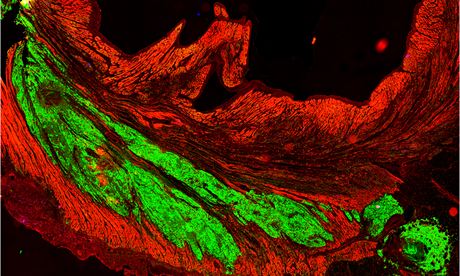
Cardiac cells derived from human stem cells (green) and monkey heart cells (red) in a photo issued by the University of Washington. Photograph: Murry Lab/University of Washington/PA
Scientists have efficiently repaired damaged monkey hearts by injecting new heart cells created from human stem cells, paving the way for a trial in people just before the finish of the decade.
Researchers now hope that the remedy could give individuals a new lease of lifestyle following huge heart attacks that trigger scarring and in the long run heart failure.
“When human embryonic stem cells had been 1st discovered, this is just the type of treatment individuals hoped they would lead to. We are optimistic, but we are also cautious,” stated Charles Murry, who led the crew at the University of Washington in Seattle.
The heart is 1 of the poorest organs in the body at repairing itself when it sustains injury. Right after a heart attack, muscle tissue in the heart dies off, and is replaced a month or so later on with scar tissue. This does not contract like regular heart tissue, so the heart is weakened and struggles to pump blood around the body.
Much more than 100,000 people have heart attacks in Britain every single year, and one particular in three dies prior to reaching hospital. Significant heart attacks are accountable for 750,000 individuals residing with heart failure in the United kingdom. But the productive trial heralds the chance of a new approach: “We believe we can do our first patient in around 4 years in a phase-1 trial,” Murry mentioned. The study is reported in the journal Nature.
Studies in mice and rats have previously proven that injections of stem cells can help to repair damaged heart muscle, but those animals have considerably various physiology and heart rates to people.
Sian Harding, director of the British Heart Basis cardiovascular regenerative medication centre at Imperial School London, called the operate a big phase forward.
“This is as close as you can get to placing these cells into humans. It truly is actually essential, simply because this is searching at a big volume of muscle, and that has not been accomplished prior to. It truly is what you are going to need in humans,” Harding stated. “It shows us you can make the muscle, hold it there, get the blood vessels in, and have it perform even at higher heart rates.”
Murry’s crew examined the process in four pig-tailed macaques and located that the cells assisted to restore heart tissue injury. The researchers induced small heart attacks in the monkeys by blocking a heart blood vessel for 90 minutes.
For the duration of the subsequent two weeks – ahead of scar tissue had time to kind – they injected one billion younger heart cells developed from human embryonic stem cells into and around the damaged heart muscle. The animals have been offered drugs to stop their immune techniques rejecting the cells.
Most of the injected cells – all around 90% – died off. But the remainder grew into fresh heart muscle that commenced to perform with the animals’ remaining healthful heart tissue. The cells formed connections with neighbours for passing electrical signals across, and blood vessels grew into the new tissue to provide it with oxygen and nutrients.
But the procedure did not go fully smoothly. All of the monkeys that acquired human heart cells developed irregular heartbeats, or arrhythmias, which lasted for two to 3 weeks. Though none of the animals died from the arrhythmias, the dilemma will make researchers wary of transplanting the cells into humans.
The cells most likely caused irregular heartbeats simply because they were immature when they had been injected. As the cells matured in the animals, the arrhythmias subsided, Murry advised the Guardian.
“If we did this in individuals there would be a vulnerable period of a handful of weeks and they would stabilise following that, but we would favor to solve the problem prior to we treated individuals,” Murry mentioned.
Murry explained that close to a quarter of the heart muscle groups was damaged in the monkeys his group treated. Had they triggered significantly much more harm the monkeys might have died prior to the scientists had had a chance to inject them with fresh heart cells.
Harding added that rather of injecting the heart cells, one more choice might be to make grafts of heart cells in the lab and transplant them as a sheet of tissue. These could sit in excess of scarred heart tissue, and aid the heart to pump more strongly.
John Martin, professor of cardiovascular medicine at UCL, was cautious about the examine since it failed to present no matter whether the transplanted cells improved the perform of the monkeys’ hearts. The occurrence of arrhythmias was worrying as well, he extra.
Anthony Mathur, director of cardiology at Barts Well being NHS trust, is working with Martin on a trial that will see three,000 heart attack individuals across Europe infused with stem cells taken from their own bone marrow. Whilst the cells do not gather in the heart and make fresh muscle tissue, they do release chemical compounds that lessen damage and possibly assist the heart to recover. A single benefit of the procedure is that individuals do not need to have to get anti-rejection medication, simply because the cells are their own.
Peter Weissberg, health care director at the British Heart Basis, explained: “This analysis brings us 1 step closer to repairing a damaged human heart, but we nevertheless have some way to go until finally we reach our aim.”
Stem cell remedy repairs broken hearts in monkeys
Hiç yorum yok:
Yorum Gönder